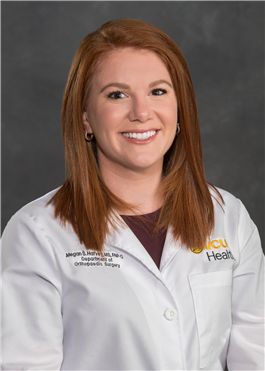Spine Injuries & Conditions
Spinal injuries and conditions don’t have to affect your quality of life: research and clinical advances have enhanced the diagnosis, treatment and outcomes for thousands of patients. Our orthopaedic experts treat spinal tumors, infection, deformity and trauma.
Common Orthopaedic Spine Conditions and Injuries
The spine is made up of small bones called vertebrae and the spinal cord which contains nerves. Running from the base of the skull to the tailbone, the spine is your body’s central support structure. There are many conditions that affect the spine.
When the spinal cord in the neck becomes compressed, or squeezed, it can cause cervical myelopathy. This is often the result of normal wear and tear as we age but can also be caused by injury. Symptoms tend to progress over time and can be identified as weakness, tingling or numbness in the hands and arms. This can significantly affect one’s balance. Loss of some fine motor skills, such as tying your shoes or buttoning buttons can also occur.
Cervical radiculopathy, also known as a pinched nerve, occurs in the top of the spine at the neck. Pinched nerves are common and can affect anyone, but individuals over 50 are at highest risk. Arthritis, injury from a sport or accident, obesity and pregnancy can all be causes. Since this area of the spine affects the arms and hands, symptoms include numbness, pain or tingling in those areas.
The spine has disks between each vertebrae. The disks in the spine act as shock absorbers when we walk or run. A herniated disk occurs when the inner area of the disk is pushed out. Many herniated disks are a result of the natural wear and tear of the spine, but other risk factors include a sedentary lifestyle, gender (men are more likely to experience this) and improper lifting of heavy objects. Lower back pain is the most common symptom, but weakness or pain in the legs and feet can also occur if the herniated disc pushes against the nerves.
Lumbar stenosis is the narrowing of the spinal canal. This creates pressure on the nerves in your spinal cord and is most common in the lower back. Lumbar stenosis is frequently caused by arthritis, the gradual wear and tear of your joints. Symptoms include difficulty walking distances, pain, numbness, or weakness in your legs and needing to lean forward to relieve pressure on your back.
Neurogenic claudication is often caused by lumbar stenosis. The inability to walk 100- 150 meters without pain and numbness or tingling down the front or back of legs are common symptoms. Severe cases may cause leg weakness, the inability to lift your toes or weakness in your gait while walking.
The sciatic nerve branches from your lower back through your hips and down each leg. The compression of this nerve is referred to as sciatica. It can be caused from a herniated disc, bone spur or the narrowing of the spine. Pain on one side of your body that radiates from the lower back is the most common symptom. It can also sometimes feel like a burning sensation or an electric shock.
Common Orthopaedic Spine Treatments
We take a team approach and partner with radiologists, physiatrists and therapists. On-site diagnostic and therapeutic interventions can be performed to assist your treatment plan and goals.
Over the counter anti-inflammatory medications (sometimes called NSAIDs) such as aspirin (Bayer, Excedrin), ibuprofen (Advil, Motrin) and naproxen (Aleve) can help alleviate pain associated with the hand and wrist. Note that acetaminophen (Tylenol) is not an anti-inflammatory medication. It can help relieve pain but doesn’t contain any anti-inflammatory properties. Diclofenac (Voltaren) gel is a topical anti-inflammatory that is often recommended. Prescription NSAIDs are also frequently prescribed.
Epidural steroid injections may be used to reduce inflammation in an area around your nerves, which often results in less pain. Injections help manage pain from arthritis, herniated discs, and sciatica.
Physical therapy may be prescribed to relieve back pain or can be used to strengthen the spine after surgery. This includes working with a qualified physical therapist on various stretches and exercises to increase flexibility and strength.
In advanced cases, or when other treatment options aren’t effective, surgery may be an option in relieving the symptoms. We work with you to ensure you are prepared for life both before and after your procedure.
During your first appointment, you and your provider will discuss your condition and potential treatment options.






